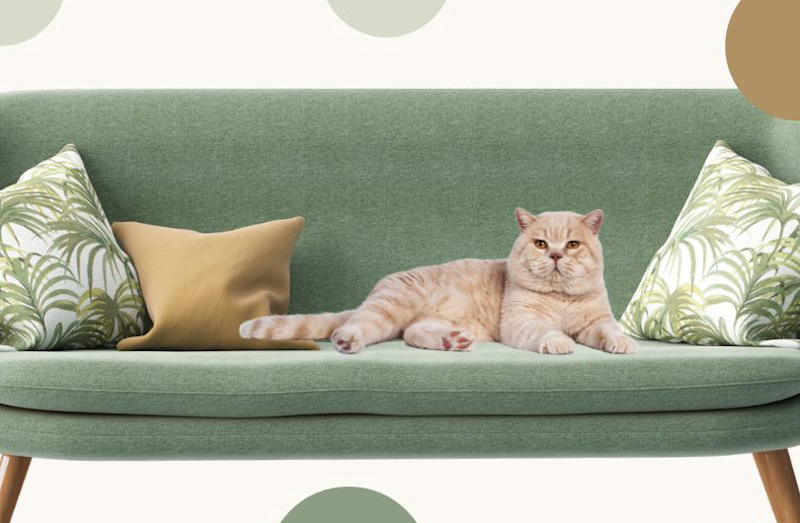Through numerous studies and careful research about the link between the evolution of the disease called feline hyperthyroidism and the introduction of fire retardants into homes, it has been found that there is a distinct link between feline hyperthyroidism and flame retardants.
The primary chemical in flame retardants is polybrominated diphenyl ethers (PBDEs). They are endocrine disruptors. PBDEs were introduced into sofas to help suppress fires but also in all kinds of products including computers. They are/were ubiquitous in the home.
 |
| Image: MikeB |
And it is worse than that because as one journalist correctly says: PBDEs are "itinerant". This means that they travel around a home because they leach out of the product where they been put by the manufacturer into the home environment. They attached to dust in the environment and therefore they remain in the environment for a long time in the form of dust.
This, as I understand it, makes them particularly hazardous for domestic cats because they lie around the home resting and then they self-groom themselves fastidiously at which point they are likely to ingest some of this dust. The PBDEs then cause cancers in the thyroid gland which leads to hyperthyroidism - an increase in the production of thyroid. This increases the metabolism of the cat which means that despite eating well they lose weight.
You might not know this but hyperthyroidism is also called thyroid cancer as it is almost always associated with a cancer, a benign adenoma (more common) already malignant adenocarcinoma. The cancers have a major effect on the production of thyroid by stimulating production. It is said, by the way, that Himalayan cats and Siamese cats have a lower risk for this problem.
The elderly cat with hyperthyroidism suddenly becomes very active after being very passive together with an increase in their appetite. This sedate older cat spending days in the sun is suddenly flying around the house like a kitten. Despite the increasing appetite and eating more there is weight loss, vomiting and panting.
This illness was not present in domestic cats until the 1970s. The veterinarians scratched their heads when it first arrived because they had no idea what it was. As it was in the 1970s that the manufacturers of numerous different products introduced PBDEs into these products.
And going back as long as 2016, we have a study on the DVM 360 website which clearly states that hyperthyroidism in cats is linked to PBDE exposure.
The opening sentence of the report on their study states: 'Cats with hyperthyroidism had significantly higher serum levels of polybrominated diphenyl ethers (PBDEs) than did euthyroid cats, investigators reported recently in Environmental Science & Technology'. The word "euthyroid" means normal thyroid function. Scientists do like to use clever words which make the reports more confusing.
This report confirms an older report linking feline hyperthyroidism to the same chemicals. The problem, and this is a big problem as I see it, although PBDE have been banned in numerous countries in numerous products the ban has not been universal and as mentioned these chemicals are likely to be in many homes even today years after they were first introduced.
The prevalence of feline hyperthyroidism in older cats is at about 10-25%. I don't know exactly how prevalent it is but at least one in 10 older cats have the disease which is a big number. If there are about 10 million elderly cats in America which there might be at a rough guess, this means that 1 million of them at least have hyperthyroidism. This is a big number and it should not be accepted. It confirms to me that there PBDEs remain in homes in 2023.
One study from Japan as I understand it concluded that some domestic cats develop hyperthyroidism from the wet food products that they eat which is based upon fish contaminated by PBDEs. Specifically, they say that the cats were exposed to these chemicals through food products containing 'fish flavours'.
I suppose the point to make is that cat owners should not accept feline hyperthyroidism as an inherited disease. It is a disease from the environment in which they live and that environment is human-made. Feline hyperthyroidism is a human created disease and it affects millions of cats across the world. We should be uneasy with that and a lot more needs to be done to resolve the matter.
The cure for this disease is quite difficult. It may include surgery or drugs or radioactive iodine as I understand it. These are all difficult procedures it seems to me. I don't see enough being done to prevent the disease occurring.
For example, does America import products from countries where they have not banned PBDEs? I don't know but it is unlikely. Big countries like India have not banned PBDEs to anywhere near the extent that they are banned in America or Europe.
In Europe Directive 2003/11/EC, which amends Directive 76/769/EEC on the marketing and use of certain dangerous substances and preparations, bans the sale of two commercial mixtures of PBDEs, known as PentaBDE and OctaBDE, in concentrations higher than 0.1% by mass. That does to seem to be comprehensive to me. Governments are reluctant to restrict businesses as they are heavily lobbied.


No comments:
Post a Comment
Your comments are always welcome.